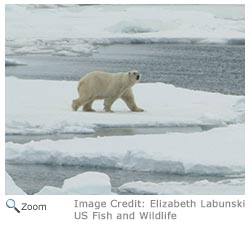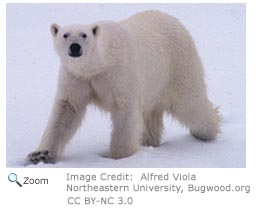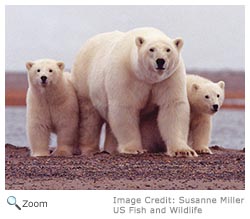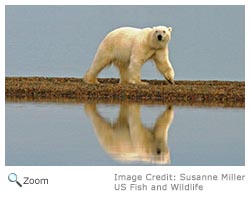Habitat
 Although the polar bear is sometimes found on the tundra, it usually lives near the water and often goes on ice floes in the ocean in search of food. It is dependent on the pack ice that is found in the arctic. Polar bears will move from one floating ice floe to the next in search of food.
Although the polar bear is sometimes found on the tundra, it usually lives near the water and often goes on ice floes in the ocean in search of food. It is dependent on the pack ice that is found in the arctic. Polar bears will move from one floating ice floe to the next in search of food.
Diet
 The primary food source for the polar bear is seals. It also eats fish, seabirds, and sometimes caribou. In the summer, the polar bear may also eat berries and other plants.
The primary food source for the polar bear is seals. It also eats fish, seabirds, and sometimes caribou. In the summer, the polar bear may also eat berries and other plants.
Life Cycle
 Polar bears mate every other year in mid-summer. The female digs a den in the snow and stays there for nine months until her young are born. She has 1-4 cubs. The cubs are hairless and toothless when they are born and are about the size of a chipmunk! The cubs stay with their mother for one to two years.
Polar bears mate every other year in mid-summer. The female digs a den in the snow and stays there for nine months until her young are born. She has 1-4 cubs. The cubs are hairless and toothless when they are born and are about the size of a chipmunk! The cubs stay with their mother for one to two years.
Behavior
 The polar bear is nomadic. It travels to find its food. It often follows seals as they migrate south. The polar bear usually travels alone and stays near the water's edge. It is a very good swimmer and spends a lot of time in the water hunting for seals. The polar bear can swim as far as 60 miles without resting and can swim at speeds of up to six miles an hour. It can dive to depths of 15 feet and can stay under water for about two minutes.
The polar bear is nomadic. It travels to find its food. It often follows seals as they migrate south. The polar bear usually travels alone and stays near the water's edge. It is a very good swimmer and spends a lot of time in the water hunting for seals. The polar bear can swim as far as 60 miles without resting and can swim at speeds of up to six miles an hour. It can dive to depths of 15 feet and can stay under water for about two minutes.